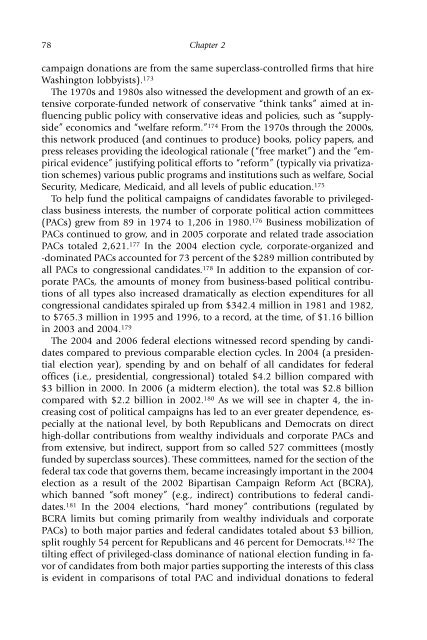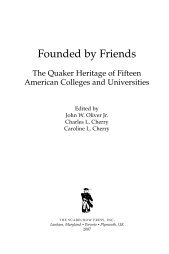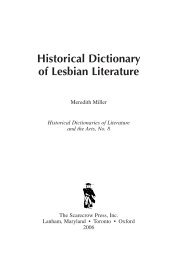Separate Realities: The Dream and the Iceberg - Scarecrow Press
Separate Realities: The Dream and the Iceberg - Scarecrow Press
Separate Realities: The Dream and the Iceberg - Scarecrow Press
Create successful ePaper yourself
Turn your PDF publications into a flip-book with our unique Google optimized e-Paper software.
78 Chapter 2<br />
campaign donations are from <strong>the</strong> same superclass-controlled firms that hire<br />
Washington lobbyists). 173<br />
<strong>The</strong> 1970s <strong>and</strong> 1980s also witnessed <strong>the</strong> development <strong>and</strong> growth of an extensive<br />
corporate-funded network of conservative “think tanks” aimed at influencing<br />
public policy with conservative ideas <strong>and</strong> policies, such as “supplyside”<br />
economics <strong>and</strong> “welfare reform.” 174 From <strong>the</strong> 1970s through <strong>the</strong> 2000s,<br />
this network produced (<strong>and</strong> continues to produce) books, policy papers, <strong>and</strong><br />
press releases providing <strong>the</strong> ideological rationale (“free market”) <strong>and</strong> <strong>the</strong> “empirical<br />
evidence” justifying political efforts to “reform” (typically via privatization<br />
schemes) various public programs <strong>and</strong> institutions such as welfare, Social<br />
Security, Medicare, Medicaid, <strong>and</strong> all levels of public education. 175<br />
To help fund <strong>the</strong> political campaigns of c<strong>and</strong>idates favorable to privilegedclass<br />
business interests, <strong>the</strong> number of corporate political action committees<br />
(PACs) grew from 89 in 1974 to 1,206 in 1980. 176 Business mobilization of<br />
PACs continued to grow, <strong>and</strong> in 2005 corporate <strong>and</strong> related trade association<br />
PACs totaled 2,621. 177 In <strong>the</strong> 2004 election cycle, corporate-organized <strong>and</strong><br />
-dominated PACs accounted for 73 percent of <strong>the</strong> $289 million contributed by<br />
all PACs to congressional c<strong>and</strong>idates. 178 In addition to <strong>the</strong> expansion of corporate<br />
PACs, <strong>the</strong> amounts of money from business-based political contributions<br />
of all types also increased dramatically as election expenditures for all<br />
congressional c<strong>and</strong>idates spiraled up from $342.4 million in 1981 <strong>and</strong> 1982,<br />
to $765.3 million in 1995 <strong>and</strong> 1996, to a record, at <strong>the</strong> time, of $1.16 billion<br />
in 2003 <strong>and</strong> 2004. 179<br />
<strong>The</strong> 2004 <strong>and</strong> 2006 federal elections witnessed record spending by c<strong>and</strong>idates<br />
compared to previous comparable election cycles. In 2004 (a presidential<br />
election year), spending by <strong>and</strong> on behalf of all c<strong>and</strong>idates for federal<br />
offices (i.e., presidential, congressional) totaled $4.2 billion compared with<br />
$3 billion in 2000. In 2006 (a midterm election), <strong>the</strong> total was $2.8 billion<br />
compared with $2.2 billion in 2002. 180 As we will see in chapter 4, <strong>the</strong> increasing<br />
cost of political campaigns has led to an ever greater dependence, especially<br />
at <strong>the</strong> national level, by both Republicans <strong>and</strong> Democrats on direct<br />
high-dollar contributions from wealthy individuals <strong>and</strong> corporate PACs <strong>and</strong><br />
from extensive, but indirect, support from so called 527 committees (mostly<br />
funded by superclass sources). <strong>The</strong>se committees, named for <strong>the</strong> section of <strong>the</strong><br />
federal tax code that governs <strong>the</strong>m, became increasingly important in <strong>the</strong> 2004<br />
election as a result of <strong>the</strong> 2002 Bipartisan Campaign Reform Act (BCRA),<br />
which banned “soft money” (e.g., indirect) contributions to federal c<strong>and</strong>idates.<br />
181 In <strong>the</strong> 2004 elections, “hard money” contributions (regulated by<br />
BCRA limits but coming primarily from wealthy individuals <strong>and</strong> corporate<br />
PACs) to both major parties <strong>and</strong> federal c<strong>and</strong>idates totaled about $3 billion,<br />
split roughly 54 percent for Republicans <strong>and</strong> 46 percent for Democrats. 182 <strong>The</strong><br />
tilting effect of privileged-class dominance of national election funding in favor<br />
of c<strong>and</strong>idates from both major parties supporting <strong>the</strong> interests of this class<br />
is evident in comparisons of total PAC <strong>and</strong> individual donations to federal
















